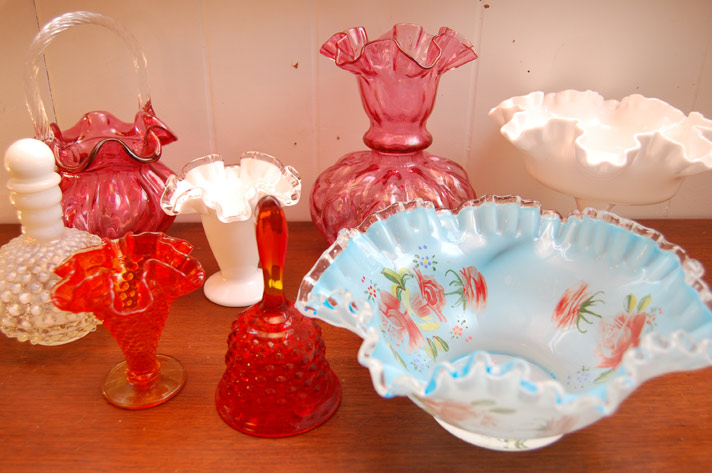Speaking of Antiquing – September 2017
Anyone who comes in to our shop will instantly see that we love antique and vintage glass. While we rarely get “big name” glass makers’ items in-stock, such as “Tiffany” or “Stuben,” you will see the classic “Fenton” glass.
Fenton glass has been around since Frank and John Fenton (brothers) set up shop in Ohio in 1905. After moving to Williamstown, West Virginia in 1907, the brothers got busy and created a legacy that collectors covet to this day.
Between 1907 and 1908, the Fenton Company created and produced the poor-man’s Tiffany-style iridescent glass called “Iridill,” that came to be known as “Carnival Glass.” Fenton dominated the market for nearly a decade with this beautiful glassware, having created over 130 patterns, some of which are quite valuable today.
Fenton’s glassware is just plain pretty. The colors are lovely, and the designs are delicate as well as functional. To get through the depression of the 1930’s, Fenton produced many household items such as plates, and mixing bowls. Later in the 1930’s to mid-1940’s we see ruffled-edged vases, candy dishes, and serving pieces aplenty.
While Europe was at war in this time, Fenton began producing perfume bottles and vanity items that are among my personal favorites. Cranberry glass, a lovely pink-red glass, became a huge success. You will find we have a fine selection of this, as well.
The glassmakers toyed with looping a handle to create a basket from bowls. To their delight, these were widely received and became instantly popular. They made wonderful flower arrangement centerpieces, made in a wide range of shapes and colors.
This is also the era when Fenton reintroduced the Victorian-style “Hobnail” to its glassware, whose uniformly bumpy surface resembled the bottoms of hobnail boots. In the 1950’s Fenton continued the use of hobnail and introduced it to their ever-popular milk glass.
Mid-century modern would be nothing without a good pair of Fenton milk glass hobnail lamps, or a pole lamp with milk glass hobnail shades.
Since many glass companies produced hobnail items, one way to spot a Fenton is to feel it. If the hobnails are pointy, it’s a Fenton.
Fenton did not begin marking its glassware until the ‘baskets’ in 1953. The glass blower’s impressed design will be found at the base of each side of the basket handle. In the Fenton history logs, one can research who used what design and when.
Fenton items typically had a foil label until the 1970’s when a circled Fenton (in script) was added to the mold. Collectors will pay a higher price for early items with foil labels still attached.
The molded, circled Fenton with a number “8” indicates production in the 1980’s; a “9” 1990’s; and “0” 2000’s.
The Fenton Glass Company ceased glassware production in 2011.

 Margaret Barns is co-owner of Pickety Place Antiques & Collectibles located at 130 N. 4th Street in Jacksonville. LIKE them on
Margaret Barns is co-owner of Pickety Place Antiques & Collectibles located at 130 N. 4th Street in Jacksonville. LIKE them on